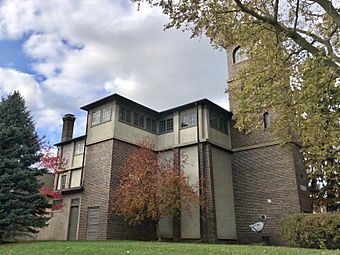Riverbank Laboratories facts for kids
Quick facts for kids Riverbank Laboratories |
|
|---|---|
| Riverbank Labs, Riverbank Acoustical Laboratory | |
 |
|
| Location | 1512 S. Batavia Ave. Geneva, Illinois |
| Built | 1918 |
| Built by | Wallace Sabine, George Fabyan |
| Website | https://riverbankacoustics.com/ |
| Part of | Riverbank Estate |
| Reference no. | 60134-33022 |
|
Riverbank Laboratories
|
|
 |
|
| Lua error in Module:Location_map at line 420: attempt to index field 'wikibase' (a nil value). | |
| Location | 1512 Batavia Ave., Geneva, Illinois |
|---|---|
| Area | 3.5 acres (1.4 ha) |
| Built | 1912 |
| Architect | Wilson Brothers |
| Architectural style | Bungalow/Craftsman |
| NRHP reference No. | 03001204 |
| Added to NRHP | November 28, 2003 |
Riverbank Acoustical Laboratories (RAL) is a special place that tests how different materials handle sound. It's often called Riverbank or Riverbank Labs. This important testing center was started by George Fabyan way back in 1913.
Riverbank Labs is still a highly respected place for testing materials. They check things like how well walls block sound (Sound Transmission Loss), how much sound a material can soak up (Sound Absorption), and how much noise travels through floors when someone walks on them (Impact Sound Transmission). They also measure how much sound a machine makes (Sound Power).
You can find Riverbank Labs at 1512 Batavia Ave. in Geneva, Illinois. This location also has a museum and a library all about sound.
Contents
History of Riverbank Labs
The building for the sound laboratory was paid for and built by Colonel George Fabyan. It was part of his huge Riverbank Estate in Geneva, Illinois. Colonel Fabyan was very interested in unusual sciences. People started talking about his "Riverbank laboratories" as early as 1916.
In 1913, Fabyan hired Wallace Clement Sabine, a famous scientist. Sabine was asked to help with a machine that was supposed to make things float using sound. This machine was based on ideas from an old book. Sabine eventually showed the Colonel that the machine wouldn't work. Even so, they became good friends.
Sabine often complained about his old sound lab at Harvard University. Colonel Fabyan then agreed to build a brand-new, top-notch sound testing facility for Sabine to use on his property. This new lab had a special room called a reverberation chamber.
Leadership Changes Over Time
Sadly, Sabine passed away in 1919, not long after the lab was finished. His cousin, Paul Sabine, took over running the lab. Paul improved the testing methods and made the lab a very successful business.
After Paul retired, the lab was managed by Hale Sabine. Later, it became part of the Armour Research Foundation, which was connected to the Illinois Institute of Technology. This foundation was renamed IITRI in 1963. In the 1960s, IITRI helped the lab grow a lot. They added a new facility for testing how much sound materials block.
In 2002, the technology parts of IITRI, including Riverbank Acoustical Laboratories, became a new company called Alion Science and Technology. Today, Alion continues to do advanced sound testing at the facility. They work for many companies that make sound-related materials and for government groups.
Secret Codes and National Service
In its early days, the Riverbank facility also had a team that worked on secret codes. They tried to figure out messages from old books and also enemy military communications. Colonel Fabyan let the U.S. Government use Riverbank Laboratories during World War I. German and Mexican secret messages were decoded there.
Much of this important code-breaking work was done by William and Elizebeth Friedman. In 1993, the National Security Agency (NSA) honored their work. They placed a special plaque that thanked Colonel Fabyan and his Riverbank Laboratories. It recognized their secret help during a very important time before America joined World War I. Because of its history, the building is now recognized in the National Register of Historic Places.
Notable Staff Members
Many talented people have worked at Riverbank Laboratories, including:
- William F. Friedman
- Elizebeth Smith Friedman
- Agnes Meyer Driscoll
- Wallace Clement Sabine
- Elizabeth Wells Gallup
Gallery





